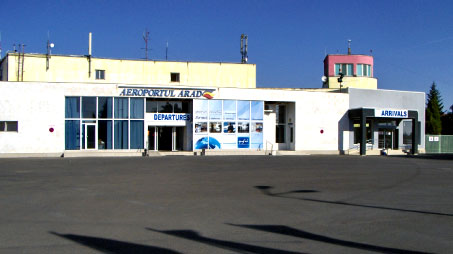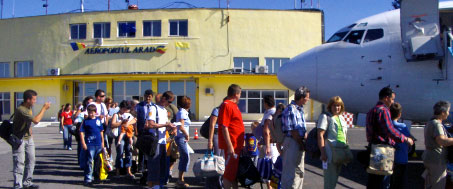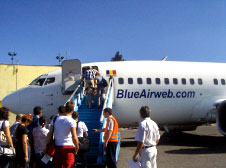
The airport is investing around €10 million on two major expansion projects to be completed within three years – an updated passenger terminal and a runway extension. Work on the terminal will begin next year.
Arad International Airport may be small, but it will be well-known to regular readers of ACI EUROPE’s monthly traffic reports. It frequently posts triple-digit growth – +779.4% in June for example – and, while starting from a low base, those figures are undoubtedly impressive and are indicative of the airport’s ambitious growth agenda.
This return to growth follows a period in which the airport was hit hard by the global economic crisis. Ryanair and Blue Air cancelled operations and traffic fell dramatically from 160,000 passengers in 2008 to just 2,000 in 2009. The airport remained resolute in its potential to attract new air services, supported by its geographical position as a gateway to western Romania, and embarked on a strategy to secure new low-cost operations. Wizz Air responded, and in June 2012 it launched a twice-weekly service to Milan-Bergamo, complementing its existing service from Timisoara to Milan-Bergamo and highlighting its confidence in the demand for capacity between Romania and northern Italy. This Milan-Bergamo operation remains Arad’s only regular scheduled passenger service, while DHL operates a daily cargo service to Budapest. A dedicated cargo terminal was built in 2002, with EU assistance, and 2,000 metric tonnes of cargo are currently handled each year.

Grec Mircea, Chief Engineer, Arad International Airport: “It may be possible to open new routes from Arad operated by Wizz Air. In any case, while we do not have any specific targets, I am convinced that Arad International Airport has the potential to significantly increase both passenger and cargo traffic.”
A key challenge is the proximity of Timisoara Airport, Romania’s second-busiest, located only 60km south of Arad International Airport, but Mircea explained that the airport is trying to convince more low-cost carriers of the traffic potential that exists at Arad and the possibility of profitable business opportunities. Domestic flights to Bucharest are another key goal. “Our advantages represented by location, accessibility, very good infrastructure and lower airport charges will always be opportunities that we must capitalise on,” said Mircea. “Low-cost flights are the most appropriate for the level of income of the population living in the airport’s catchment area. I am convinced that our airport has the potential to provide passengers at least for services to Italy, Spain, France, Germany, UK, Ireland, Belgium and the Netherlands.”
His belief is that throughput will reach 100,000 this year, helped by the fact that Wizz Air relocated its Timisoara traffic to Arad for two weeks during the summer season, while runway repairs were undertaken. “It may be possible to open new routes from Arad operated by Wizz Air. In any case, while we do not have any specific targets, I am convinced that Arad International Airport has the potential to significantly increase both passenger and cargo traffic,” added Mircea.
While EU rules on State aid would allow Arad County, the airport’s owner, to make a limited provision for start-up aid to airlines launching new routes, it has yet to practice this form of stimulation for the airlines. However, a generous incentive scheme is in place to encourage carriers to open new routes, ranging from a 5% reduction in landing charges for 6-9 movements per month, to a 50% reduction for more than 160 movements per month.

Arad International Airport expects to handle 100,000 passengers this year and is embarking on a terminal expansion that will provide a modern, efficient facility for up to one million passengers per year.
Terminal and runway extension

Arad International Airport has experienced a return to growth. It was hit hard by the global economic crisis, with Ryanair and Blue Air cancelling operations, but posted triple-digit growth in June.
The airport is investing around €10 million on two major expansion projects to be completed within three years – an updated passenger terminal and a runway extension. Work on the terminal will begin next year and will increase annual capacity to one million passengers. The current, dated terminal was built in 1936, and the investment will provide a modern, efficient facility for passengers. Meanwhile, the 350m runway extension is necessary as the new Arad bypass inaugurated last year passes nearby and has reduced the runway threshold by 180m, meaning the Landing Distance Available (LDA) is currently 1,820m. The extension will ensure a proper, safe landing distance for A320 and 737 type aircraft.
While the Arad bypass, linking Romania and Hungary, has necessitated a runway extension, it does, importantly, provide excellent accessibility to the airport. It may also contribute to attracting new air services as it effectively increases Arad International Airport’s catchment area to include eastern Hungary. As Mircea points out, “There is no other airport between Arad and Budapest.”
“I personally am an optimist and I have no reason not to believe in the future of Arad International Airport. The aviation market is growing. Arad County is one of the most developed in Romania economically, and the political and administrative leadership of Arad County is very interested in the airport’s development,” he added.
The airport certainly doesn’t lack ambition. It is investing to provide sufficient future capacity and developing a keenly-focused strategy aimed at attracting new low-cost carriers. Load factors of more than 80% on the Wizz Air service suggest the potential is there to significantly increase passenger traffic, and we await with interest the next stage in the airport’s air service development.







